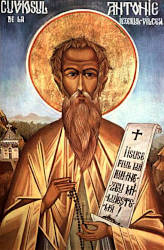Peștera Sfântului Antonie de la Iezer
Useful Information

| Location: |
Above Iezer Monastery in Vâlcea.
From Râmnicu Vâlcea 64A west 12 km to Valea Cheii River, turn left 9 km to the monaster. From the monastery 500 m/20 min walk through the forest uphill to the cave church. (45.205839, 24.176876) |
| Open: |
no restrictions. [2021] |
| Fee: |
free. [2021] |
| Classification: |
 Cave Church Cave Church
|
| Light: | candles, bring torch |
| Dimension: | w=6 m, H=3 m. |
| Guided tours: | self guided |
| Photography: | allowed |
| Accessibility: | no |
| Bibliography: | |
| Address: | Peștera Sfântului Antonie de la Iezer. |
| As far as we know this information was accurate when it was published (see years in brackets), but may have changed since then. Please check rates and details directly with the companies in question if you need more recent info. |
|
History
| 1690 | Anthony starts to live as a hermit and dug a cave church. |
| 23-NOV-1719 | Anthony died. |
| 20-JUN-1992 | Canonization of Anthony. |
Description


The Peștera Sfântului Antonie de la Iezer (Cave of St. Anthony of Iezer) is a small cave church dedicated to Saint Anthony. Anthony was born into a Vlach family in Pindus, the mountainous land of northern Greece. in 1648 he relocated to Wallachia. At the age of 64, after a hectic life as a merchant, he chose the monastic life. Bishop Ilarion of the Diocese of Râmnicu sent him to the Iezer Monastery.
But he wanted to live as hermit, and so he moved to a hermitage above the monastery. He had discovered a small cave and in a dream he had seen a church built into the cave. So for 28 years he lived a simple and busy life building the church. He died in 1719 at the age of 92 and his remains were brought to the monastery where he was buried in the church. In 1992, he was canonized.
The old icon on this page show the saint in his typical pose, with a long beard, a cross and a pergament in his hands. In the background is the monastery and the cave. These examples are from the cave church, the monastery and one is sold in thousands as a cheap copy. Obviously as an old man in the 18th century living as a hermit and underweight he most likely looked much more bulimic. More like a modern day homeless, but the holy halo definitely helps.
If you are in the area and visit the monastery anyway, it’s definitely a must to spend the hour and walk to the cave church. The place is tranquil and quite nice.
 Search DuckDuckGo for "Peștera Sfântului Antonie de la Iezer"
Search DuckDuckGo for "Peștera Sfântului Antonie de la Iezer" Google Earth Placemark
Google Earth Placemark Peștera Sfântului Antonie de la Iezer
Peștera Sfântului Antonie de la Iezer  (visited: 25-AUG-2021)
(visited: 25-AUG-2021) Index
Index Topics
Topics Hierarchical
Hierarchical Countries
Countries Maps
Maps